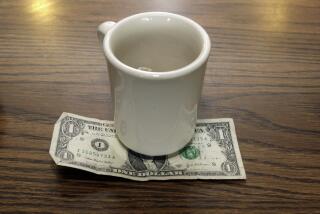What to do at the tipping point
- Share via
So let me ask you a question about the tip jar. I had a little thing with the calzone guy this week. I go to drop a buck in the tip jar and just as I am about to drop it in, he looks the other way. And then when I am leaving, he gives me this look [like] thanks for nothing. I mean if they don’t notice it, what’s the point?
-- George Costanza, “Seinfeld,” 1996
It may be a hand-painted tin can, a stray paper cup or a corporate-issue plexiglass cube, but it’s becoming a fixture: the tip jar.
With managers allowing or even encouraging behind-the-counter employees to solicit tips, customers are suffering Costanza-like angst. Does everyone who pours you a cup of coffee merit a little something extra? Or just the guy who remembers that you like tuna-on-rye-hold-the-lettuce?
“People care tremendously about not being seen as cheap, and they don’t want to look extravagant,” says Peter Post, a director with the Emily Post Institute in Burlington, Vt. (He is her grandson.) No surprise, then, that the etiquette advice organization has been fielding more questions about handling the ubiquitous tip jar. Post says the answer is: whatever makes you feel comfortable.
That’s easy when it comes to waiters at sit-down restaurants. These men and women have long depended on tips to supplement their pay, as have beauticians, doormen and a long list of service workers. For them, gratuities can exceed hourly pay and are a way for customers to acknowledge and reward special service.
Now that tip jars are common at coffeehouses, taco stands and other places where speed and uniformity are the goals, rather than personalized service, when and how much is a topic not only for the Emily Post Institute but on websites such as yelp.com and starbucksgossip.typepad.com. (On Yelp, Wilbur L. says he doesn’t think a tip is warranted for “30 seconds worth of balling up ice cream and plunking it down into a cone or extracting the espresso from the coffee machine.” Will on the Starbucks gossip site wonders, “Do I need to start tipping the supermarket checkers for checking out my groceries???”)
Workers commonly divide up the cash in the tip jar according to their time on duty. And though the cash is the sole property of employees under state and federal law, Los Angeles attorney Richard Simmons says, workers are supposed to report their tips as income.
For Raymond Calayag and Minah Kwon, who work at Cold Stone Creamery in West Los Angeles, tip money makes a big difference. Their take from the two tip jars can be as much as $100 a week.
“It’s great,” says Calayag, 25. “I always have cash in my pocket.”
Their tips have also made them both into regular tippers; Calayag says he leaves a dollar or two in the Starbucks jar when he buys coffee because “we know how it feels.”
Cold Stone has made tipping part of its marketing. To play up what company spokeswoman Anne Christenson calls the “fun, energetic” spirit, ice-cream scoopers are encouraged to burst into song when a customer drops a buck in the jar. Cold Stone gives new employees songbooks with ice-cream themed lyrics to classic tunes like “Twinkle, Twinkle Little Star.”
The singing is such a hit that people sometimes try to cue the choir with a George Costanza-like move, says Kwon, 19. They sneak a dollar out of the jar and then drop it back in, and Kwon says she usually catches pranksters in the act.
Sarah Jacobus doesn’t need a serenade or even personalized service to tip.
“As I’ve gotten older, I’ve become a more liberal tipper and more conscious of people working in the service sector and the reality of what they do,” says Jacobus, 56, a substitute teacher and a regular at a Mar Vista Starbucks.
Social consciousness aside, most people tip to express appreciation for a cashier who remembers their name or favorite food, Post says. Although 70% of respondents in a survey his institute conducted in 2003 said they felt no obligation to tip, most said they shelled out when they felt it’s warranted.
That makes sense to Paul Hibler, co-founder of Pitfire Pizza. He thinks most of his patrons feed the tip jars at his three Los Angeles restaurants as an honest gesture of appreciation for the staff and the food. Some, in fact, leave even more tip money on the table when they finish eating.
Kwon figures she received the ultimate gesture of appreciation last Valentine’s Day, when a man begged her to open the store after she and her crew mates had already closed up for the night. He was desperate to buy an ice cream cake for his sweetie, and so grateful that she opened the doors that he dropped $60 in the jar.
Kwon thought he had made a mistake. “You tipped us $60,” she called out to him as he headed for the door. “It’s for you,” he replied.
She’s hoping the last-minute Romeo comes back this year.
More to Read
Inside the business of entertainment
The Wide Shot brings you news, analysis and insights on everything from streaming wars to production — and what it all means for the future.
You may occasionally receive promotional content from the Los Angeles Times.










